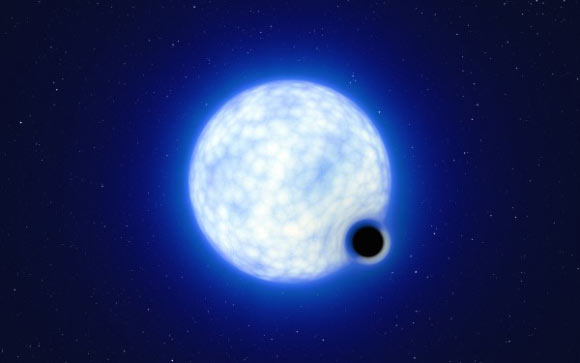The newly-detected black hole is a member of the binary system VFTS 243, which is located in the famous Tarantula Nebula in the Large Magellanic Cloud.

This artist’s impression shows what the binary system VFTS 243 might look like if we were observing it up close. The system, which is located in the Tarantula Nebula in the Large Magellanic Cloud, is composed of a hot, blue star with 25 times the Sun’s mass and a black hole, which is at least nine times the mass of the Sun. The sizes of the two binary components are not to scale: in reality, the blue star is about 200,000 times larger than the black hole. Image credit: ESO / L. Calçada.
Stellar-mass black holes form when massive stars reach the end of their lives and collapse under their own gravity.
In a binary system, this process leaves behind a black hole in orbit with a luminous companion star.
The black hole is ‘dormant’ if it does not emit high levels of X-ray radiation, which is how such black holes are typically detected.
“For the first time, our team got together to report on a black hole discovery, instead of rejecting one,” said Dr. Tomer Shenar, an astronomer at Amsterdam University.
“We found that the star that gave rise to the black hole vanished without any sign of a powerful explosion.”
“Though other similar black hole candidates have been proposed, this is the first ‘dormant’ stellar-mass black hole to be unambiguously detected outside of the Milky Way Galaxy.”
The newly-found black hole is at least 9 times the mass of the Sun, and orbits a hot, blue star weighing 25 times the Sun’s mass.
Known as VFTS 243, TIC 277299822 and 2MASS J05380840-6909190, this binary system is located some 160,000 light-years away in the constellation of Dorado.
It resides within the Tarantula Nebula, the most spectacular feature of the Large Magellanic Cloud, a small satellite galaxy of the Milky Way.
The discovery was made thanks to six years of observations obtained with the Fibre Large Array Multi Element Spectrograph (FLAMES) instrument on ESO’s Very Large Telescope.
“It is incredible that we hardly know of any dormant black holes, given how common astronomers believe them to be,” said Dr. Pablo Marchant, an astronomer at KU Leuven.
“For more than two years now, we have been looking for such black-hole-binary systems,” added Dr. Julia Bodensteiner, an astronomer at ESO.
“I was very excited when I heard about VFTS 243, which in my opinion is the most convincing candidate reported to date.”
The discovery also allows the astronomers a unique view into the processes that accompany the formation of black holes.
“We believe that a stellar-mass black hole forms as the core of a dying massive star collapses, but it remains uncertain whether or not this is accompanied by a powerful supernova explosion,” Dr. Shenar said.
“The star that formed the black hole in VFTS 243 appears to have collapsed entirely, with no sign of a previous explosion.”
“Evidence for this ‘direct-collapse’ scenario has been emerging recently, but our study arguably provides one of the most direct indications.”
“This has enormous implications for the origin of black-hole mergers in the cosmos.”
The team’s paper will be published today in the journal Nature Astronomy.
_____
Tomer Shenar et al. 2022. An X-ray quiet black hole born with a negligible kick in a massive binary of the Large Magellanic Cloud. Nature Astronomy, in press; doi: 10.1038/s41550-022-01730-y







